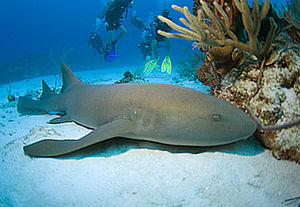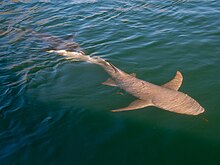Nurse sharks
| Nurse sharks | ||||||||||||
|---|---|---|---|---|---|---|---|---|---|---|---|---|

|
||||||||||||
| Systematics | ||||||||||||
|
||||||||||||
| Scientific name | ||||||||||||
| Ginglymostomatidae | ||||||||||||
| Gill , 1862 |
The nurse sharks (Ginglymostomatidae) are a species-poor family of sharks . They are close relatives of the carpet sharks (Orectolobatidae) and the whale sharks (Rhincodontidae). In English they are known as nurse shark .
The four species of nurse shark are found on both sides of the Atlantic, on the coast of the eastern Pacific (California to Chile), in the tropical Indo-Pacific and in the Red Sea .
features
These are small to large sharks that can reach a length of 75 cm to 4.30 m. Your trunk is slightly flattened dorsoventrally. Nurse sharks have nasoral pits connected to the mouth, short to long barbels on the nostrils and very small injection holes behind the eyes. A nictitating membrane is missing. Your rostrum is short and ends blunt to rounded. The relatively small mouth is covered with small teeth. The gill slits 4 and 5 are very close to each other above the pectoral fin and almost overlap.
Nurse sharks have two stingless dorsal fins, the second begins well in front of the anal fin. The tail fin stalk is remarkably short, shorter than the head and without pits or keels. The number of vertebrae is 135 to 195. The upper side of the body is usually gray, yellow, yellow-green or red-brown in color, while the underside of the body is lighter. Young animals are spotted dark.
Way of life
Nurse sharks are sluggish, gregarious and ground-dwelling sharks that are found on rocky or coral reefs and on sand and muddy surfaces from the intertidal zone to depths of around 70 meters. The prey of nocturnal hunters includes various invertebrates such as sea urchins , lobsters , crabs , octopuses or squids , but also bony fish . When hunting, nurse sharks show the typical behavior of suckling , whereby they simply suck out prey hidden in crevices or under rubble by opening their mouths and quickly expanding their throat.
All nurse sharks reproduce - like most cartilaginous fish - ovoviviparously ( yolk sac - viviparity ), so they are viviparous . The pairing is done, as in sharks usual, by introducing the Klaspers of the male animal in the cloaca of the female. The fry are born fully developed.
They are only dangerous to humans if they are provoked.
Genera and species

- Genus: Ginglymostoma
Hermann , 1783
- Atlantic nurse shark ( Ginglymostoma cirratum ( Bonnaterre , 1788) )
- Ginglymostoma unami Del-Moral-Flores , Ramírez-Antonio , Angulo & Pérez-Ponce de León , 2015
- Genus: Nebrius Rüppell , 1837
- Indo-Pacific nurse shark ( Nebrius ferrugineus ( Lesson , 1831) )
- Genus: Pseudoginglymostoma Dingerkus , 1986
- Short-tailed nurse shark ( Pseudoginglymostoma brevicaudatum ( Günther , 1867) )
literature
- Joseph S. Nelson : Fishes of the World . John Wiley & Sons, 2006, ISBN 0-471-25031-7 .
- Kurt Fiedler: Textbook of Special Zoology, Volume II, Part 2: Fish . Gustav Fischer Verlag Jena, 1991, ISBN 3-334-00339-6 .
Web links
- Nurse Sharks on Fishbase.org (English)